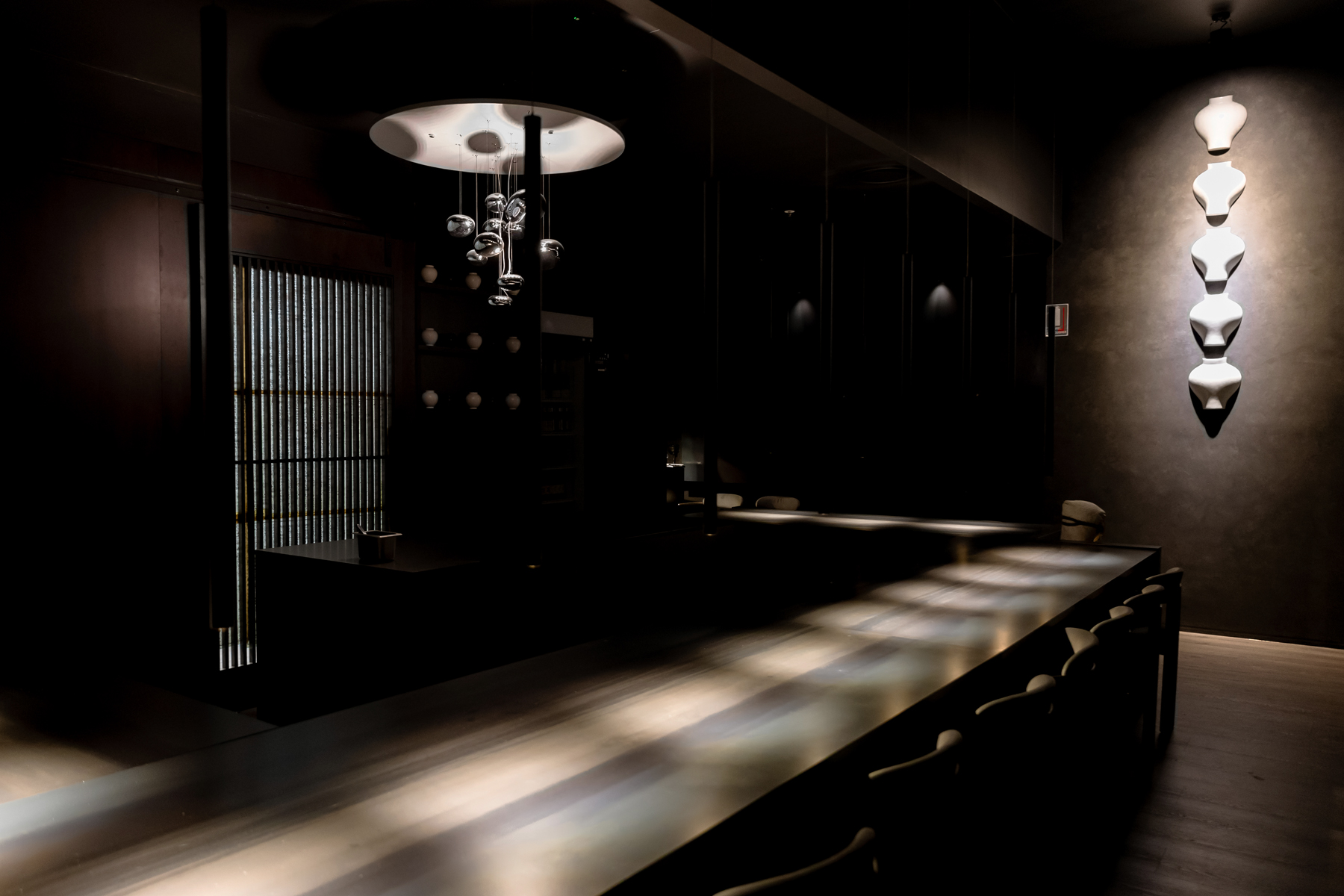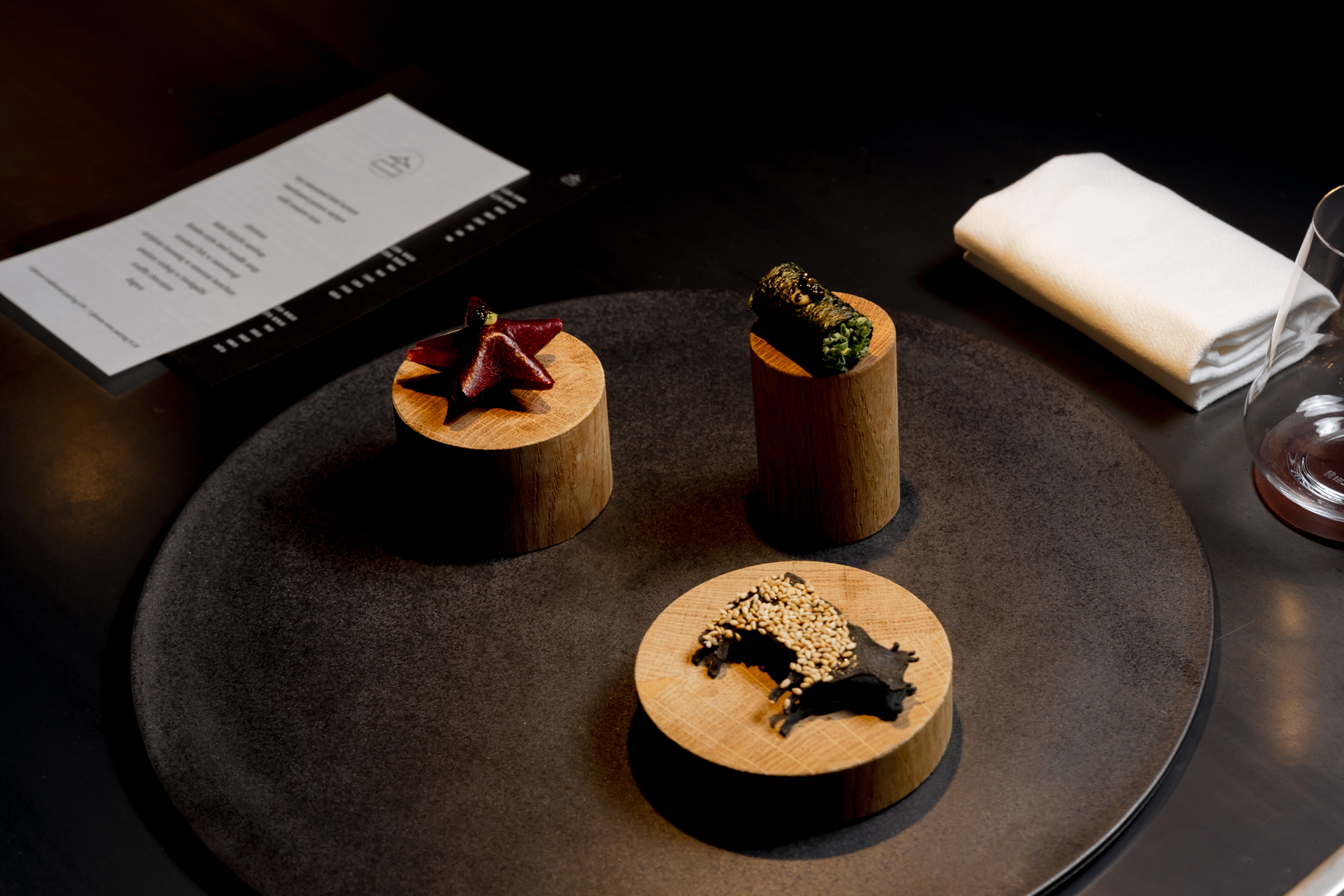Korean tradition meets molecular gastronomy at SUUM, Brisbane’s newest omakase restaurant














You’ll find SUUM behind an unmarked door in a quiet Charlotte Street lobby. Inside, the lights are low, the palette is dark and the room hums with quiet anticipation. At this 16-seat fine diner, chef Andy Choi (ex-The Fat Duck, Disfrutar) applies molecular gastronomy to Korean flavours, crafting a boundary-pushing omakase that’s unlike anything else in Brisbane.
If there’s one rule to dining at SUUM, it’s don’t forget to breathe.
It might seem like a silly thing to be mindful of, but once seated inside the restaurant – shrouded in shadow, as if a play is about to commence – it’s easy to find yourself holding your breath in anticipation.
But chef Andy Choi wants people to inhale and relax. He named his new restaurant SUUM – which means ‘to breathe’ in pure Korean – as a form of encouragement to guests, prompting diners to really immerse themselves in the experience, to forget that the outside world exists and melt into the restaurant’s moody surroundings for a few hours.
With SUUM, Andy is showcasing Korean cuisine through an ultra-modern lens. By applying molecular gastronomy techniques – skills he picked up while cutting his teeth at Heston Blumenthal’s heralded fine-diner The Fat Duck and Disfrutar in Barcelona – Andy is transforming traditional Korean dishes into works of edible art, showcasing a side of his native cuisine that goes beyond the familiar.
“I think this kind of Korean fine dining has never really existed in Brisbane,” says Andy, who also operated his own restaurant Andy Pandy back in Korea. “I want customers to come in and feel, breathe, eat and experience – just in this space.”

You might like
Located in a nondescript lobby off Charlotte Street, SUUM is part restaurant, part theatre.
The room is purposefully dark by design, wrought from a mixture of black timber, carbon steel and cement. Ornamentation is minimal, and the bulk of the room’s illumination comes from an intricate light fixture in the middle of the space and a number of slender cylindrical pendant lamps that hang above each seat.
Approximately 16 guests sit in a U-shaped configuration around a central counter, where Andy applies finishing touches to dishes that emerge from the separate kitchen space. Dishes are finished and plated on custom tableware (designed by Andy and hand-crafted in Korea), before being brought to each seat and placed in the little bubble of light cast by the lamps above.
SUUM’s palette and atmosphere serves to cut out distractions, drawing attention to the food Andy and his team painstakingly create.
“What I wanted was lighting just on the table so that people can only see and concentrate on the food,” says Andy, who chuckles when he says that he’d have made the room darker if he could.

SUUM’s guests are treated to an omakase-style menu that moves to the rhythm of the seasons – a procession of approximately 14 courses that subverts expectation and play with form and flavour.
“I want to keep the traditions of Korea, but I also want to seek for the future,” says Andy of SUUM’s intent. “The flavor of each dish is similar to a traditional Korean dish, but the look and presentation is more like molecular gastronomy.”
SUUM’s current menu leads with a trio of snacks, including soy-seasoned beef tartare, marinated-prawn tartare and wild-sesame tuna.
From there, the plates get larger and more intricate. Dubu kimchi sambap, dombe-style beef noodle soup and steamed fish with maesaengi (a Korean seaweed) are followed by showstoppers including a striploin hansang with seasonal banchan and abalone sotbap (pot rice with tteokgalbi, a style of grilled short-rib patties). The dinner finishes with truffle chocolate and dagwa (Korean teas and sweets).
As particular Korean ingredients are hard to find in Australia, Andy has had to get creative and find new pathways to reach his desired destination. This means Andy creates as much as possible in house, from the soybean paste served alongside samgyeopsal to SUUM’s own makgeolli.
“To make rice wine, we need a particular ingredient called nuruk (a traditional Korean fermentation starter made with wheat, rice, and barley), but it’s impossible to get it in Australia,” explains Andy. “So, what I tried to do was mix the half-cooked rice with shio koji and champagne yeast.
“It was my first time trying it, but it actually worked well – it has more fruity, banana and nutty flavors in it.”
Speaking of beverages, guests can sample makgeolli, yakju and cheongju alongside a list of French and Australian wines, with three- and five-glass pairing options available.
SUUM is more than a restaurant – it’s a meditation on Korean cuisine, reimagined through Andy’s exacting lens. Here, innovation and tradition don’t compete, but collaborate. It’s a place where every element is intentional, every bite considered.
Come curious, come open, but most importantly, come ready to breathe.
Head to The Directory for operating hours and booking details.

